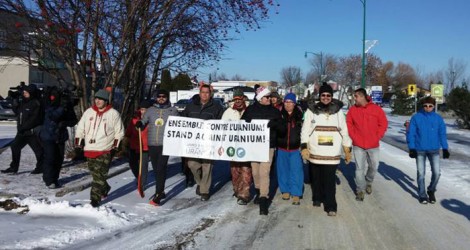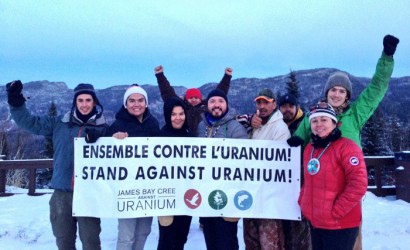Article Origin
Volume
Issue
Year
The Cree Nation in Quebec has taken a stand against uranium development and mining in their territory, Eeyou Istchee.
To bring public awareness and to garner support, youth of the Cree Nation embarked on the Stand Against Uranium Walk on Sunday, Nov. 24. They began their walk in Mistissini, said Joshua Iserhoff, Youth Grand Chief of the Cree Youth Council for the Cree Nation government.
Their ultimate destination was Montreal where they hand-delivered a message to the final day of the BAPE (Bureau d’audiences publiques sur l’environnement) hearings on Dec. 15. They walked about 850 kms.
“This stand has been totally initiated by the youth in the community of Mistissini, a community in northern Quebec where the anti-uranium fight started,” said Iserhoff. It’s where Strateco Resources, a uranium company sought to pursue the Matoush advanced exploration project on Mistissini family hunting grounds.
Strateco came into the territory and set up the Matoush uranium project in 2006, Iserhoff said, without holding any community consultations. The Matoush project is located in the Otish Mountains, about 275 km north of Chibougamau and 210 km northeast of Mistissini and is now considered one of the highest-grade uranium projects in the world.
The Stand Against Uranium Walk was in the planning for the last year, said Iserhoff, as the youth sought not only to educate themselves, but also the elders in the community by using YouTube and community consultations.
“They even brought in a uranium specialist, Dr. Gordon Edwards, and he did a community consultation on what the effects of uranium are,” he said. Learning about the devastating effects of uranium mining on the land ignited their passion, he said, and “that’s why Strateco really lost its luster.”
“We do occupy the land. We do not want our waters or our lands to be contaminated because we do live off the land. We love to fish, we love to hunt and we want the land to be in its natural state,” Iserhoff said. This is the message presented to the BAPE hearing on behalf of the Cree Nation youth.
Twenty-one young people have been walking an average of 30 to 45 kms a day. “After 750 kms, it gets challenging,” Iserhoff said. A winter walk allows for a shorter walk, he said,” because the lakes are frozen and you can just walk on them.”
They’ve been hitting some of the towns that are affected by uranium mining to broaden their base of support. Iserhoff said they’ve met with positive feedback on their journey and, “none of us have heard anything negative,” he said.
“Some people understand the effects of uranium, but there’s such a large number who just aren’t aware of this project. We’re the ones taking the initiative to be ambassadors to Quebec, Canada and the world.”
The Cree Stand has sparked rallies in other provinces and people are talking to their MPs and, “we have people following us on Twitter,” he said. “We’re protecting the land for future generations, not just for the Cree people or Aboriginal people, but for everybody.”
The Cree Nation was successful in getting a moratorium on uranium development. The moratorium ends in 2015.
“One thing I’ve been taught,” Iserhoff said, “is never to give up hope and if there is bad news, we must continue to fight. This is one thing the Cree people have always been known for is to be fighters. We’ve been challenged as a nation, but we’ve stood our ground because this is something that is really close to our hearts and we do not want the lands and waters to be contaminated and destroyed by uranium.”
The Cree youth have been building relationships with other Indigenous groups affected by uranium. An international conference is in the works that will bring together the Navajo and the Dene with the Cree.
Iserhoff said his own epiphany occurred on a hunting trip with his father, mother and sister when he shot a bear. They were on his grandfather’s hunting grounds. He watched his mother gather spruce and “we laid the bear on the bed of spruce boughs,” he said.
“I remember thinking at that moment, this is really special. In the Cree territory, it is the highest honour to get a bear. I looked at the bear and its fat was so thick and I knew that this bear ate from the land and drank from Lake Mistissini. I didn’t want any of our animals living in the area to be contaminated and sick because of uranium. I wanted that moment I experienced with my family to be experienced by future generations.”
The youth have developed a website to continue the awareness. Check out www.standagainsturanium.com for more information about their initiatives.
- 2206 views


